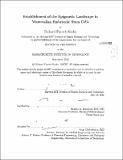Establishment of the epigenetic landscape in mammalian embryonic stem cells
Author(s)
Koche, Richard Patrick
DownloadFull printable version (15.91Mb)
Other Contributors
Harvard--MIT Program in Health Sciences and Technology.
Advisor
Bradley E. Bernstein.
Terms of use
Metadata
Show full item recordAbstract
Temporal and spatial variation of histone methylation is an important factor in mammalian development. Deciphering the details of such epigenetic phenomena has the potential to enrich both stem cell biology and therapeutics, as well as offer insight into various pathologies. While the enzymatic machinery responsible for these transitions is well known, it is their localization to specific genomic regions that controls cell fate, and this has largely remained a mystery. The goal of this thesis was to use an integrative genomics approach to elucidate the role of cis elements in the establishment of repressive chromatin domains. To this effect, we determined the genetic basis for localization of Polycomb repressive complexes (PRCs) in mammalian embryonic stem (ES) cells. First, by generating genomewide chromatin state maps in mouse and human by high throughput sequencing, we utilized a comparative and motif dictionary approach to computationally identify potential Polycomb recruitment elements. Surprisingly, we found that PRC recruitment is best explained by localization to clusters of unmethylated CpG dinucleotides, elements originally associated with gene activation. Next, in a series of transgenic assays involving human and E. coli sequence, we were able to reconstitute the chromatin state of an epigenetic memory element in mouse ES cells. Finally, we found that as somatic identity is reset during induced pluripotent stem (iPS) cell reprogramming, these same elements are central to a coordinated response in which active chromatin domains are established prior to and independently of transcription. Taken together, these studies highlight the role of a particular cis element in the establishment of both active and repressive chromatin domains. Furthermore, this dynamic underscores how a static genetic element can be utilized to enable the chromatin-based plasticity required of stem cell differentiation and lineage specification.
Description
Thesis (Ph. D.)--Harvard-MIT Program in Health Sciences and Technology, 2012. Cataloged from PDF version of thesis. Includes bibliographical references.
Date issued
2012Department
Harvard University--MIT Division of Health Sciences and TechnologyPublisher
Massachusetts Institute of Technology
Keywords
Harvard--MIT Program in Health Sciences and Technology.